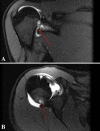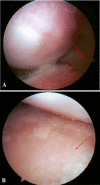Case reports: two cases of glenohumeral chondrolysis after intraarticular pain pumps
- PMID: 20112077
- PMCID: PMC2919888
- DOI: 10.1007/s11999-010-1244-5
Case reports: two cases of glenohumeral chondrolysis after intraarticular pain pumps
Abstract
Background: Acute idiopathic chondrolysis in young adults is rare. The etiology often is unknown and outcomes can be devastating owing to rapid development of painful secondary osteoarthritis. There have been some recent reports of chondrolysis after arthroscopic shoulder procedures. Animal and laboratory data suggest chondrolysis is related to the use of intraarticular pain pumps, although there is no conclusive evidence that this is causative in patients.
Case description: We present two cases of young adults with chondrolysis of the humeral head after intraarticular pain pump use with humeral head resurfacing and biologic glenoid resurfacing.
Literature review: Several authors report glenohumeral chondrolysis after shoulder arthroscopy involving the use of bupivacaine pain pumps. In addition, experimental animal studies have confirmed the presence of chondrolysis after bupivacaine infusion.
Purposes and clinical relevance: These cases provide additional evidence of an important association between postarthroscopic chondrolysis of the glenohumeral joint and the use of bupivacaine pain pumps.
Figures



References
-
- Coobs BR, LaPrade RF. Severe chondrolysis of the glenohumeral joint after shoulder thermal capsulorrhaphy. Am J Orthop. 2009;38:E34–E37. - PubMed
Publication types
MeSH terms
Substances
LinkOut - more resources
Full Text Sources
Medical

